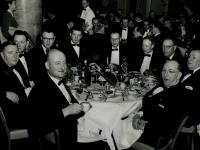Answer: The Friendly Sons of Saint Patrick.
Between its founding in 1771 and its incorporation as the Hibernian Society for the Relief of Emigrants from Ireland in 1792, the Friendly Sons was primarily a fraternal group for men of means. At its first meeting, there were twenty-four regular members and six honorary members. Their membership was particularly affected by the Revolutionary War, when at least a dozen of them joined the military ranks. After the war, the group continued to meet, but their numbers dwindled. In the early 1790s, when the war had ended and relations with Europe resumed, America saw an influx of emigrants from Ireland, many of whom were poor. In response, the Hibernian Society for the Relief of Emigrants from Ireland was incorporated and was chaired by John M. Nesbitt, then president of the Friendly Sons. Gradually, the membership and activities of the Friendly Sons were absorbed by the Hibernian Society. In 1898, the Hibernian Society changed its name to the Society of the Friendly Sons of Saint Patrick for the Relief of Emigrants from Ireland.
HSP has a collection of the Friendly Sons’s records (#1152), which contain minute books, portraits of early members, constitutions and by-laws, dinner programs, and addresses. HSP also has a volume of papers from Stephen Moylan (Am .6035). And in addition to having several books in the library on the history of the Friendly Sons, we also hold several manuscript collections highlighting Irish heritage and history, such as Robin O’Brien Hiteshew papers (#3059), the Dennis Clark papers (MSS 177 and MSS 037), the James J. Cleary papers (#3063), and the Patrick Stanton papers (MSS 031).

